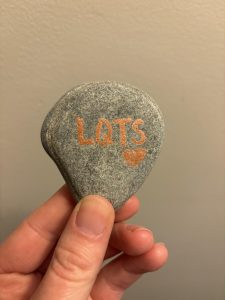 When Shane and Kristi’s middle son suddenly lost his hearing in 2022, their son underwent genetic testing to try and find the cause – which revealed a genetic variant for Long QT Syndrome Type 2. Kristi and her family were shocked – until they realized that ‘seizures’ Shane had experienced years earlier might have actually been heart episodes.
When Shane and Kristi’s middle son suddenly lost his hearing in 2022, their son underwent genetic testing to try and find the cause – which revealed a genetic variant for Long QT Syndrome Type 2. Kristi and her family were shocked – until they realized that ‘seizures’ Shane had experienced years earlier might have actually been heart episodes.
“Twenty years ago, my husband had some scary events we never really understood,” says Kristi. “At the time, he was diagnosed with a seizure disorder. The first time, I woke up from sleep to a thumping sound, and he was on the ground.”
A few times, Shane would wake up on the floor with no memory of what happened. He tried multiple medications for his seizures, and even lost his license and a job change was in part due to these events. A few years after his last episode, he came off of the seizure medication – and the events stopped entirely.
“When we got the genetic testing results, we realized that his events weren’t brain-related at all – they were related to his LQTS and dangerous heart rhythms,” says Kristi. “It rocked us. We realized how many times his life had been spared by the Lord; nobody was there with an AED, and yet he survived.”
“When we got the genetic testing results, we realized that his events weren’t brain-related at all – they were related to his LQTS and dangerous heart rhythms.”
Kristi and Shane proceeded to genetically test their other two children. This brought the total count of LQTS in their little family up to three: Shane, their middle son, and their oldest son are all affected.
In November of the same year, Kristi took her daughter (who tested negative for LQTS) to her yearly checkup. Her pediatrician heard a heart murmur; because their family had been through so much that year, she was referred to cardiology to rule out any issues. An ECHO discovered a congenital heart defect – bicuspid aortic valve.
“She was excited to join her brothers in our family ‘heart club,’” says Kristi.
Since then, Kristi’s family has adjusted to “life in the stripes” – they’re a rare disease family.
“AEDs come with us everywhere,” says Kristi. “Everyone’s on heart meds and has regular checkups. There’s been both challenges and joys: we’ve gotten to connect with incredible people we would never have met otherwise.”
For those with a recent heart diagnosis in their family, Kristi emphasizes the importance of open communication.
“It’s important for your kids to know that how they’re feeling mentally is just as important as how they’re feeling physically.”
“It’s super important to share age-appropriate medical info with your kids,” she says. “They need language to talk about their heart condition, and to understand (on a basic level) what their doctors are saying. It’s also important for them to know that how they’re feeling mentally and emotionally is just as important as how they’re feeling physically. We’ve used counselors through our heart center for them as well as us.”
As her children grow, Kristi has also learned the importance of flexibility – adjusting her parenting, and her children’s understanding of their condition, to each season of her children’s life.
“When they start getting close to the teen years, they start asking new questions, and there’s a need to balance freedom and safety,” says Kristi. “We work hard to make sure that they’re not defining themselves by their condition, and that our family isn’t ruled by fear.”
As they age, Kristi also helps them understand their condition with new language so they can communicate with others – including peers and doctors.
Every year, Shane remembers the day he survived his very first ‘seizure’ – which they now know was actually a dangerous heart rhythm episode. “That was a big day in our story,” says Kristi. “He’s been soberly yet gratefully remembering long before he even knew it was heart-related. It’s a milestone day that could have had a very different ending. We’re so grateful to know about these conditions, and do what we can to keep our family safe.”

This article deeply touched me. It highlights the emotional and practical challenges of living with a rare heart condition but also shows incredible resilience and family support. The message about open communication with children is especially powerful.